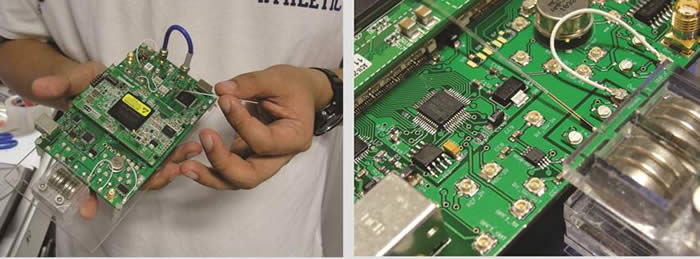Portable Magnetic Resonance Relaxometry System - Micro/Nanofluidic BioMEMS Group
Development of miniaturized, portable Magnetic Resonance Relaxometry System for Point-of-Care Medical Diagnosis
With advances in microelectronics technology, Magnetic Resonance (MR) community sees the emergence of much more compact MR spectrometers (pulse programmer, transmitter, receiver, and digital signal processing) on a highly integrated circuit platform such as field programmable gate array (FPGA)[1], and complementary-metal oxide semiconductor (CMOS)[2]. Recently, Weissleder’s group shown that small “ping-pong sized” magnet can be packed together with a CMOS-based transceiver into a palm-sized, NMR-based biosensor[2]. Here, in MIT, SMART Centre (in Singapore) a novel, compact-sized (16cm x 9cm) and portable (250g) Magnetic Resonance Relaxometry system is designed and developed[3,4]. We overcame several key engineering barriers so that magnetic resonance technology can be potentially used for disease diagnosis-monitoring in point-of-care settings, directly on biological cells and tissues. The whole system consists of a coin-sized permanent magnet (0.76 Tesla), miniaturized radio-frequency microcoil probe[4-6], compact lumped-circuit duplexer, and single board 4-Watt power amplifier, in which a FPGA-based spectrometer is used for pulse excitation, signal acquisition and data processing. We show that by measuring the proton transverse relaxation rates from a large pool of natural abundance proton-nuclei presence in less than 1 µL of red blood cells, one can indirectly deduce the relative magnetic susceptibility of the bulk cells within a few minutes of signal acquisition time. Such rapid and sensitive blood screening system can be used to monitor the fluctuation of the bulk magnetic susceptibility of the biological cells (e.g. human red blood cells), where unusual state of the bulk magnetic susceptibility is related to a number of diseases (e.g. malaria[3,7], dengue, enzyme deficiency, inflammation, sepsis, etc.). We are looking for interested party to license this technology[8] and working together on various aspects of diseases, for drug screening etc.
References
[1] Takeda, K. A highly integrated FPGA-based nuclear magnetic resonance spectrometer. Rev Sci Instrum 78, 033103 (2007).
[2] Sun, N., et al. Palm NMR and 1-Chip NMR. Ieee Journal of Solid-State Circuits 46, 342-352 (2011).
[3] Peng, W.K. Micro Magnetic Resonance Relaxometry for label-free, rapid malaria diagnosis. Biomedical Engineering Society 2011 Annual Meeting Hartford, Boston, USA(2011).
[4] Peng, W.K., Chen, L. & Han, J. Development of miniaturized, portable magnetic resonance relaxometry system for point-of-care medical diagnosis. Rev Sci Instrum 83, 095115.
[5] Kong, T.F., Peng, W.K., Luong, T.D., Nguyen, N.T. & Han, J. Adhesive-based liquid metal radio-frequency microcoil for magnetic resonance relaxometry measurement. Lab Chip 12, 287-294.
[6] Peng, W.K. & Han, J. Biosensor, palm-sized device and method based on Magnetic Resonance Relaxometry. (WO Patent 2,012,118,442).
[7] Peng, W.K. Rapid detection and quantification of parasitemia level in Plasmodium falciparum infected blood via Magnetic Resonance Relaxometry. Experimental Nuclear Magnetic Resonance Conference 2011 Asilomar Conference Center, Pacific Grove, CA (2011).
[8] http://ilo.technologypublisher.com/technology/10822#.UGqiZ64ZRNM.


